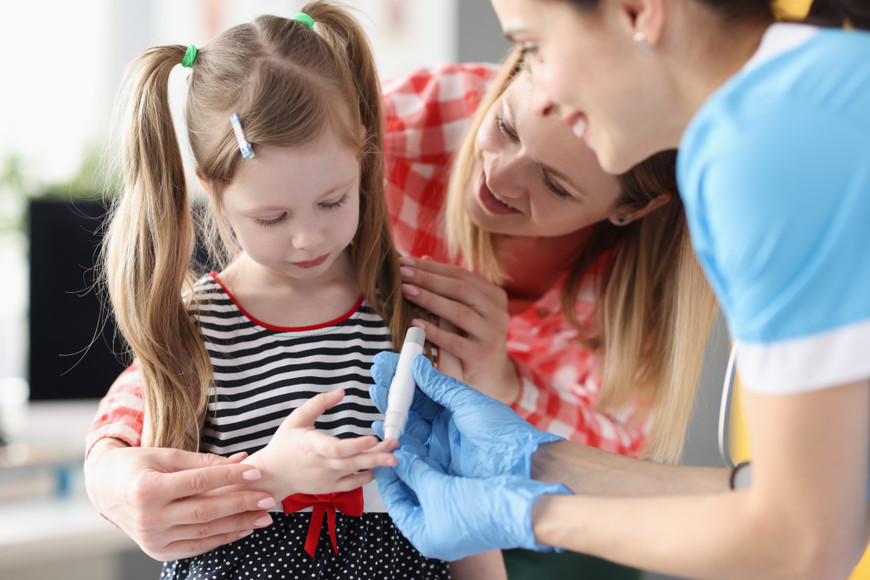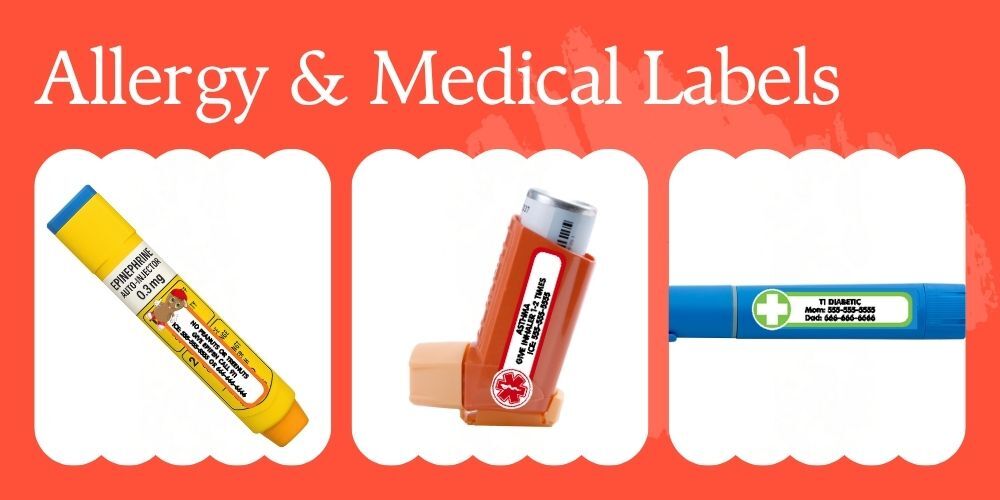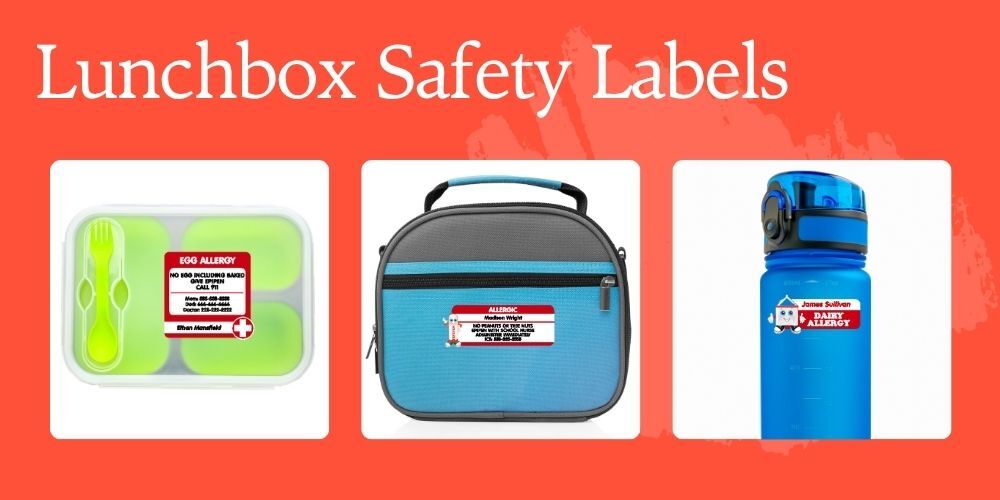School Safety for Children with Medical Conditions: A Parent's Guide to Peace of Mind
As a mom who started Sticky Monkey Labels after my second son was born—both of my boys have food allergies, and I have an adopted son with some special needs—I understand that gut-wrenching feeling of sending your child with medical conditions to school. Will the teacher remember about his severe peanut allergy? What if he has a seizure and no one knows his emergency contact information? What if the school nurse isn't there when he needs his inhaler?
You are not alone in this journey. These aren't just worries—they're valid concerns shared by thousands of parents every single day. According to recent studies, one in five parents don't feel their child with allergies is safe at school. But here's what I've learned through my own journey and from talking with countless parents in our community: the right preparation and identification systems can transform that anxiety into confidence.
You're Part of a Caring Community
Every day, I hear from parents just like you—parents who lie awake at night wondering if they've done enough to keep their child safe. Parents who've had to leave work because of a school emergency call. Parents who feel like they're fighting an uphill battle to get teachers and staff to understand their child's needs.
Your concerns are valid. Your vigilance is necessary. And you're doing an amazing job.
Sarah from Texas shared with me: "My daughter's severe peanut allergy kept me up at night until I found a system that worked. Now I sleep better knowing she has clear identification everywhere she goes, and the school staff know exactly what to do."
Understanding What You're Up Against: School Medication Realities
One thing that surprises many parents is how schools actually handle medications. Understanding these policies helps us create better safety systems for our kids.
The Reality Most Parents Don't Know
Most medications must stay with the school nurse. This includes over-the-counter medications like Tylenol, prescription medications, and even vitamins. Schools are very strict about this for safety reasons.
The few exceptions require paperwork:
- Inhalers for asthma - Your child can carry these, but you'll need written permission from both you and their doctor
- EpiPens - These life-saving devices can be carried by students, but again, documentation is required
- Diabetes supplies - Glucose meters and emergency supplies, with proper authorization
- Emergency seizure medications - For immediate use during episodes
What this means for you: Clear medical identification becomes even more critical because school staff need to know instantly what your child needs and who to call.
Making Your Child Visible and Safe
When I talk to parents who've been through medical emergencies at school, they all say the same thing: "I'm so grateful the staff knew immediately what was wrong and what to do." That's the power of proper identification.
Where to Place Medical Information for Maximum Impact
For Food Allergies
Jennifer from Arizona told me: "The bright allergy alert label on my son's lunchbox caught the cafeteria worker's attention immediately when he accidentally grabbed the wrong lunch. She stopped him before he could eat anything and called me right away."
Critical locations for allergy alerts:
- Lunchbox (most important!) - This is where food exposure happens
- Backpack front pocket - Easy for any adult to see
- Water bottle - Kids often share or mix these up
- EpiPen case - Clear identification of both the device and your child
For Seizure Disorders
Essential placement for seizure conditions:
- Backpack main compartment - Easy to find when searching for information
- Jacket or hoodie - Seizures can happen anywhere, including outdoors
- PE bag - Physical activity can sometimes trigger episodes
For Diabetes
Key locations for diabetes identification:
- Glucose meter case - With emergency contact information
- Snack container - Identifying emergency glucose supplies
- Sports equipment bag - Physical activity affects blood sugar
For Breathing Conditions
Important locations for breathing conditions:
- Inhaler case - With your child's name and your phone number
- PE bag - Exercise is a common trigger
- Backpack - Backup identification if inhaler gets misplaced
The Right Tools for the Job: Labels That Actually Work
Not all labels are created equal. When your child's safety is on the line, you need labels that will stay put, stay readable, and get noticed when it matters most.
Allergy Alert Labels: Your First Line of Defense
Our Allergy Alert Labels are designed specifically for those heart-stopping moments when every second counts.
Why parents love them:
- Bright, attention-grabbing design - They're meant to be noticed immediately
- Completely customizable - List your child's specific allergies (peanuts, shellfish, dairy, etc.)
- Waterproof and dishwasher-safe - They won't fade or peel off lunchboxes
- Multiple sizes available - Small rounds for water bottles, large rectangles for lunchboxes
What fits where:
- Rectangle labels - Perfect for lunchboxes, backpack pockets, giving to the teacher for her to place as a constant reminder
- Round labels - Great for water bottles, thermoses, small containers
- Square labels - Ideal for placing on clear bag for the nurse with your child's medications/devices, insided backpack, on larger medical devices
Real parent story: "The red allergy alert label on Emma's lunchbox has been a lifesaver. Even substitute teachers notice it immediately and know to be extra careful during snack time." - Jennifer M., Arizona
Medical Alert Labels: For Complex Conditions
Our Medical Alert Labels are perfect when you need to communicate more detailed medical information quickly.
Perfect for conditions like:
- Seizure disorders with specific emergency protocols
- Diabetes with blood sugar management needs
- Dysphagia and swallowing disorders requiring texture-modified foods
- Heart conditions requiring activity restrictions
- Autism or sensory processing considerations
- Any condition requiring immediate medical attention
What makes them special:
- More space for detailed information - Include condition name, emergency contacts, and brief instructions
- Professional medical alert design - Immediately recognizable to school staff
- Durable construction - These need to last all school year and beyond
- Easy to read fonts - Clear even in stressful situations
Where they work best:
- Backpack main compartment - Where school staff look first for information
- Medical device cases - Glucose meters, inhaler cases, etc.
- Jacket pockets - For conditions that might flare up anywhere
- Sports bags - For activity-related medical needs
Square Emergency Contact Labels: Your Lifeline
Sometimes the most critical information isn't the medical condition—it's knowing who to call. Our Square Emergency Labels ensure your child is never alone in a crisis.
Essential information to include:
- Your name and primary phone number
- Secondary emergency contact
- Your child's full name and grade
- Brief medical condition (if space allows)
- Doctor's office number
Perfect placement:
- Inside backpack main pocket - Protected but easy to find
- Lunchbox interior - Where staff often look first
- Jacket inner pocket - For outdoor emergencies
- PE bag - For sports-related incidents
You're Building a Safety Network
Remember, you're not just labeling items—you're building a comprehensive safety network around your child. Every label is a communication tool that speaks for your child when they can't speak for themselves.
Creating Your Support System at School
Your child's safety team includes:
- Classroom teacher
- School nurse
- PE teacher
- Cafeteria staff
- Playground supervisors
- Office staff
- Substitute teachers
Each person needs to know:
- Your child's medical condition
- What an emergency looks like
- How to contact you immediately
- Where emergency supplies are located
Age-Appropriate Safety Strategies
Elementary Age: Building the Foundation
Focus on clear, simple identification:
- Bright, colorful labels they can recognize
- Simple language they understand
- Multiple locations for redundancy
- Teaching them to point out their labels to adults
Middle School: Growing Independence
Transitioning to self-advocacy:
- More discrete labels that don't embarrass them
- Teaching them to speak up about their needs
- Backup systems in case they forget
- Helping friends understand their condition
High School: Preparing for the Future
Building adult skills:
- Professional-looking identification they're comfortable with
- Self-management of their medical needs
- Emergency preparedness skills
- Transition planning for college or work
You're Not Alone: Wisdom from Our Parent Community
Organization Systems That Work
The "Medical Hub" approach: Create one central location (usually the main backpack pocket) where ALL medical information lives together.
The "Rule of Three": Never put medical information in just one place. Always have it in at least three locations.
The "Substitute Teacher Lifeline": Create a special folder that stays in the classroom with your child's photo, simple medical instructions, and your contact information in large, clear print.
Communication Strategies That Build Confidence
Weekly check-ins: Many successful parents establish regular communication with key school staff—not because there's a problem, but to build relationships and keep everyone informed.
The "Good News" approach: Share positive updates about your child's condition management, not just problems. This builds confidence in your child's ability to handle their condition.
Building Your Child's Confidence
One of the most important things you can do is help your child feel confident and capable, not defined by their medical condition.
Teach them to say:
- "I have [condition], but I know how to take care of myself."
- "I need to check with an adult before [eating/doing activity]."
- "My mom/dad put labels on my things so adults know how to help me."
Help them understand:
- Their medical condition is just one part of who they are
- Lots of kids have medical conditions—they're not alone
- Being careful and prepared is smart, not scary
- The adults at school want to help keep them safe
Special Situations: You've Got This
Field Trips and Special Events
Create a "field trip kit" with extra labels and information for chaperones who don't know your child well.
Substitute Teachers
Make sure there's a bright, obvious folder in the classroom with your child's photo and basic medical information.
Sports and Physical Activities
Coaches need the same information as teachers. Don't assume the school nurse has communicated with all staff.
When Things Don't Go as Planned
Even with the best preparation, sometimes things happen. Remember:
- It's not your fault - You can't control everything
- Use it as a learning opportunity - What can be improved for next time?
- Advocate calmly but firmly - Your child is watching how you handle challenges
- Build on what works - Focus on the systems that are successful
You're Doing an Amazing Job
I want you to know something: You are an incredible advocate for your child. The fact that you're reading this article, researching safety options, and thinking ahead about potential challenges shows just how much you love your child and want them to succeed.
Every parent in our community has felt that same mix of love, worry, and determination that brought you here today. You're not being overprotective—you're being a great parent.
Your Next Steps to Peace of Mind
Ready to create a comprehensive safety system for your child? Here's how to get started:
- Assess your current situation - What medical information does your child need to have visible at school?
- Choose the right labels for your needs - Browse our complete Safety Labels collection
- Plan your placement strategy - Use the guidelines above to decide where each label should go
- Communicate with school staff - Share your safety plan with teachers, nurses, and other key personnel
- Practice with your child - Help them understand their role in staying safe
Ready to Get Started?
Your child's safety is too important to leave to chance. Our Safety Labels are designed by a parent who understands exactly what you're going through, tested by real families, and built to last through everything school can throw at them.
Explore our complete Safety Labels collection:
- Allergy Alert Labels - For food allergies and anaphylaxis
- Medical Alert Labels - For complex medical conditions
- Square Emergency Labels - Your lifeline in any crisis
- Car Seat Safety Labels - For travel and transportation safety
Remember: You're not just buying labels—you're investing in your peace of mind and your child's safety. You're building a system that speaks for your child when they can't speak for themselves.
You've got this. Your child is lucky to have you. And you're not alone in this journey.
Questions about which labels are right for your child's specific needs? I'm here to help. As a mom who's been exactly where you are, I understand the importance of getting this right.
Stay strong, stay prepared, and know that you're doing everything right.
About the Author
Dodie, Founder of Sticky Monkey Labels
I'm a mom of two boys—both with food allergies, and an adopted son with special needs—who started Sticky Monkey Labels in 2011 right after my second son was born. What began as a solution for my own family's labeling needs has grown into a mission to help thousands of families keep their children safe and organized.
I understand the sleepless nights, the worry about sending your child to school, and the constant vigilance required when your child has medical conditions. I've been the mom who gets the emergency call from school. I've been the mom who has to explain complex medical needs to yet another new teacher. I've been the mom who lies awake wondering if I've done enough to keep my child safe.
Every product we create at Sticky Monkey Labels is designed with real families in mind—families like yours and mine who need labels that work when it matters most. I personally handle customer support because I know how important it is to get the right solution for your child's specific needs.
From our family to yours, I'm here to help you create the safety and organization systems that give you peace of mind and help your child thrive.
Questions about which safety labels are right for your child? Reach out to me directly—I'm always happy to help a fellow parent.



